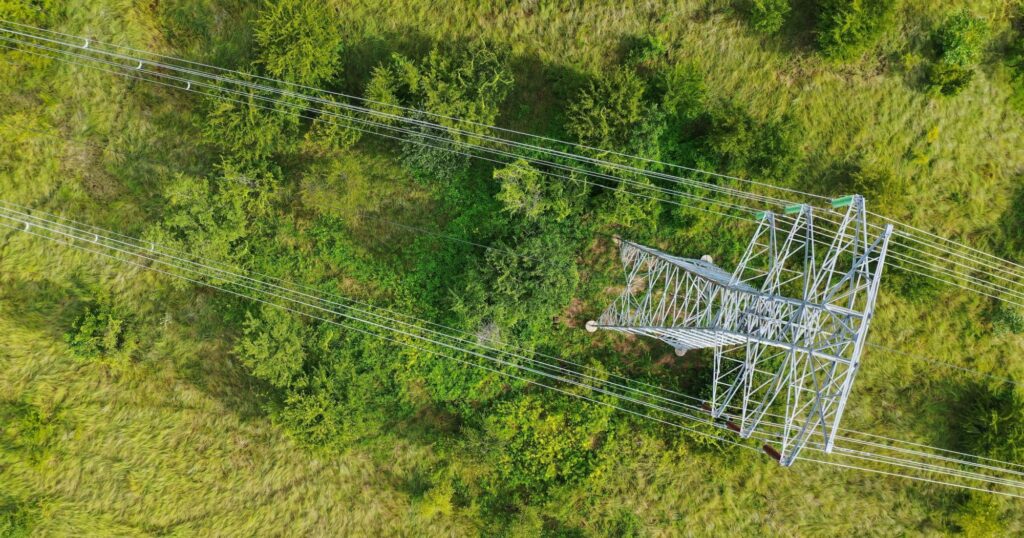If you are a Texas landowner and have received a letter from a utility company about a proposed power line project, it is easy to feel confused about what exactly is happening. You might see phrases like “transmission line routing,” “transmission line easement,” or “eminent domain,” and wonder what they all mean, and when you need to take action.
At Braun & Gresham, we represent landowners across Texas through both the transmission line routing process and eminent domain proceedings. These are two very different legal stages, but they are closely connected. Understanding the distinction between them is essential if you want to protect your land, your rights, and your future.
In this article, we explain the difference between transmission line routing vs. eminent domain, outline how the two processes unfold, and identify key moments where landowners must be prepared to act.
What Is Transmission Line Routing?
Transmission line routing is the legal and administrative process that determines the path a new high voltage power line will take across the state. This process is regulated by the Public Utility Commission of Texas, often called the PUC.
Before a power line can be built, the utility company must submit an application to the PUC and propose several possible routes. Landowners who may be affected by one or more of those routes are sent notices and are given a chance to participate in the case. This is your first opportunity to influence whether the line crosses your property at all.
Routing cases involve many different factors, including cost, environmental impact, community input, engineering feasibility, and landowner concerns. The PUC reviews all of these elements and makes a final decision about which route to approve.
Key point: Routing is about selecting the best path for the transmission line, not about compensation or property rights. Those issues come later.
What Is Eminent Domain?
Once the PUC approves a route, the utility company has the legal authority to build the line along that path. If your property falls on the approved route, the next step is acquiring a transmission line easement. This is where eminent domain comes into play.
Eminent domain is the legal power that allows certain entities, including utilities, to take private land for public use. In this context, that means creating a permanent easement across your land for the construction and maintenance of a high voltage power line. This legal process is called condemnation, and it is focused on one thing: just compensation.
Key point: Eminent domain is about acquiring legal rights to your land and determining what you should be paid. It begins only after the routing decision has been made.
How the Two Processes Connect
It is easy to confuse routing with eminent domain because they are part of the same overall project timeline. However, they are handled by completely different bodies and involve very different questions.
- Transmission line routing is decided by the Public Utility Commission
- Eminent domain proceedings happen in the county where the land is being taken and where a condemnation lawsuit could be filed in a court.
Routing is about where the line will go. Eminent domain is about acquiring the land rights needed to build it.
Importantly, landowners who participate in the routing case often can have a stronger position when it comes time for easement negotiations or condemnation. By voicing your concerns early, you can help steer the route away from sensitive areas or potentially avoid it crossing your land altogether.
What Is a Transmission Line Easement?
A transmission line easement is a legal agreement that allows a utility to build and maintain a power line across your property. The landowner retains ownership of the land, but the easement limits what you can do with it and gives the utility access.
Most easements are permanent and allow for a wide range of activities, including vegetation clearing, equipment upgrades, and vehicle access. The specific language in the easement matters, because it defines what the utility can and cannot do.
In Texas, utility easements often include:
- A cleared path of land that must remain free of trees or structures
- Restrictions on building near or under the line
- A right of entry for inspections and maintenance
- Limits on future development or agricultural use
Because these easements last indefinitely and can significantly impact property value, it is essential that landowners negotiate favorable terms. Never accept the first offer without legal review.
What Happens During Easement Negotiation?
After the PUC approves the route, the utility or their right of way agent will contact affected landowners to begin negotiations. You may be offered a lump sum payment in exchange for signing a standard easement agreement. These offers often come with pressure to act quickly.
At Braun & Gresham, we recommend taking the following steps before signing anything:
- Have the proposed easement reviewed by a lawyer
- Request an appraisal or valuation of the impact to your land
- Negotiate the terms of the easement language
- Consider long term impacts, not just the payout
If negotiations fail or stall, the utility may file a condemnation lawsuit to obtain the power line easement through eminent domain.
What Happens During a Condemnation Case?
If you do not sign an easement agreement, the utility will likely initiate a lawsuit, a petition in condemnation, in the local court. This process includes:
- Filing a petition to condemn
- Appointment of three special commissioners to hear the case
- A Special Commissioner’s Hearing to determine an amount of compensation
- The opportunity to appeal the Special Commissioners’ Award to the court
This process can take several months or more, depending on the complexity of the case. Many condemnation cases are resolved through further negotiation or mediation before trial.
Our team at Braun & Gresham represents clients throughout the condemnation process. We work with expert appraisers and legal professionals to make sure you are fairly compensated for the loss of property use, impact to your land, and loss of market value.
Why Timing and Strategy Matter
Many landowners wait too long to get involved. By the time condemnation begins, the route has already been approved and the utility is prepared to move forward. Your strongest opportunities to protect your property happen early, during the routing case and initial easement discussions.
It is also important to understand that utilities and right of way agents are professionals. They have teams of attorneys and experts working for their interests. Landowners should have the same level of support to make informed decisions and stand on equal footing.
Final Thoughts
Transmission line projects can have a lasting impact on your land, your privacy, and your ability to use your property the way you want. Understanding transmission line routing vs. eminent domain is the first step in protecting your rights.
If you have received a notice or believe your land may be affected by a transmission project, contact Braun & Gresham. Our experienced attorneys will help you navigate both the routing and condemnation stages, advocate on your behalf, and make sure you are treated fairly every step of the way. Do not wait until construction begins. The earlier you act, the more options you have.


